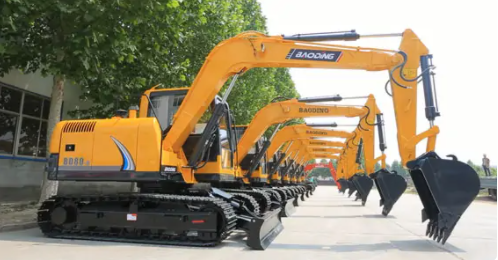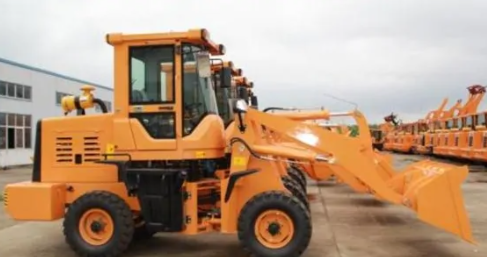The First(1), base on analyze by definition to check
The Excavator, also known as excavating machinery (excavating machinery), also known as excavator, is an earth-moving machine that uses a bucket to excavate materials above or below the bearing surface and load it into a transport vehicle or unload it to a stockyard.
The materials excavated by the excavator are mainly soil, coal, silt, soil and rock after per-loosening. Judging from the development of construction machinery in recent years, the development of excavators is relatively fast, and excavators have become one of the most important construction machinery in engineering construction. The three most important parameters of an excavator: operating weight (mass), engine power and bucket, bucket capacity.
The loader, as the name implies “loading”, its function is to load soil onto a truck, an excavator can also do it but not as good as a loader, bulldozing is just a sideline of a loader, and the loader is wheeled, so it can run on the road, Excavators, bulldozers and other crawler types can only be transported by trailers to transfer the work site, so there are generally special requirements for the drive system of the loader. , earth and stone construction machinery for construction projects such as ports and mines.
The Second(2),base on structurally check
Excavator: Common excavator structures include power plant, working device, slewing mechanism, operating mechanism, transmission mechanism, walking mechanism and auxiliary facilities, etc. The transmission mechanism transmits the power of the engine to the hydraulic motor, hydraulic cylinder, etc. through the hydraulic pump for execution components to push the working device to complete various tasks.
Loader: including engine, torque converter, gearbox, front and rear drive axles, referred to as four major parts.
The Third(3), base on Function to check
Excavator: The excavated materials are mainly soil, coal, silt, soil and rock after pre-loose. Judging from the development of construction machinery in recent years, the development of excavators is relatively fast, and excavators have become one of the most important construction machinery in engineering construction.
Loader: It is mainly used for shoveling, loading, unloading, earth-moving and bulk materials such as stones. It can also perform light shoveling operations on rocks and hard soils. If you change different working devices, you can also complete the work of bulldozing, lifting, loading and unloading other materials. In highway construction, it is mainly used for filling and excavation of roadbed engineering, aggregate and loading of asphalt and cement concrete yard.
Fourth(4), base on the classification difference from the model to check
Excavators: can be divided into large excavators, medium excavators, small excavators, crawler excavators, wheel excavators, hydraulic excavators, mechanical excavators, mining excavators, marine excavators, special excavators, etc. different categories.
Loaders: According to the engine power, they can be divided into small loaders, medium loaders and large loaders.
Excavator classification
Excavators can be divided into front shovels, backhoes, drag-lines and grab shovels. Front shovels are mostly used to excavate materials above the surface, and backhoes are mostly used to excavate materials below the surface.
Backhoes Backhoes are the most common we’ve ever seen, with a backwards-down, forced cut. It can be used for excavation below the shutdown working surface. The basic operation methods are: ditch end excavation, ditch side excavation, straight line excavation, curved excavation, excavation with a certain angle, ultra-deep trench excavation and trench slope excavation.
Front shovel excavator
The shovel action form of a front shovel excavator. Its characteristics are “forward and upward, forced soil cutting”. The front shovel has a large digging force and can excavate the soil above the stop surface. It is suitable for excavating dry foundation pits with a height of more than 2m, but up and down ramps must be set up. The bucket of the front shovel is larger than that of the backhoe excavator of the same equivalent, and it can excavate a material with a water content not greater than 27%.
The dump truck cooperates to complete the entire excavation and transportation operation, and can also excavate large dry foundation pits and mounds. The excavation method of the front shovel is based on the difference between the excavation route and the relative position of the transport vehicle. There are two ways of digging and unloading: forward digging and side unloading; forward digging and reverse To unload soil.
Drag-line excavator
Drag-lines are also called drag-lines. The characteristics of its excavation are: “backward and downward, cutting the soil under its own weight”. It is suitable for excavation of Class I and II soils below the stop surface. When working, the bucket is thrown out by inertial force, and the digging distance is relatively large, and the digging radius and digging depth are large, but it is not as flexible and accurate as the backhoe. Especially suitable for excavating large and deep foundation pits or underwater excavation.
Loader is a kind of earth and stone construction machinery widely used in highway, railway, construction, hydro-power, port, mine and other construction projects. It is mainly used to shovel bulk materials such as soil, sand, lime, coal, etc. , hard soil, etc. for light shovel excavation. It can also carry out bulldozing, lifting and loading and unloading of other materials such as wood by changing different auxiliary working devices. In roads, especially in high-grade highway construction, loaders are used for filling and excavating roadbed engineering, aggregate and loading of asphalt mixture and cement concrete yard. In addition, it can also carry out operations such as pushing soil, scraping the ground and pulling other machinery. Because the loader has the advantages of fast operation speed, high efficiency, good maneuverability, and easy operation, it has become one of the main types of earthwork construction in engineering construction.
The Fifth(5), base on distinguish from application to check
Excavator: An excavator is an engineering vehicle used to excavate or move large objects.
Loader: The loader is mainly used for shoveling, loading, unloading, earth-moving and bulk materials such as stones, and can also perform light shoveling operations on rocks and hard soils. If you change different working devices, you can also complete the work of bulldozing, lifting, loading and unloading other materials. In highway construction, it is mainly used for filling and excavation of roadbed engineering, aggregate and loading of asphalt and cement concrete yard.
The Sixth(6), base on the main components to check
Excavator: Common excavator structures include power plant, working device, slewing mechanism, manipulation mechanism, transmission mechanism, walking mechanism and auxiliary facilities. The main components of the excavator chassis are: rollers, idlers, sprockets, drive teeth, track shoes, and chain rail assemblies.
Loader: including engine, torque converter, gearbox, front and rear drive axles, referred to as four major parts.
The work is different. The loader is mainly used for shoveling bulk materials such as soil, sand, lime, coal, etc. The excavator uses the bucket to excavate the material above or below the surface of the machine, and load it into the transport vehicle or unload the earth-moving machine to the stockyard. The excavated materials are mainly soil, coal, silt, soil and rock after pr-loosening. The structure and principle are also very different.
 Excavators, which are specially designed for excavation, but can be loaded
Excavators, which are specially designed for excavation, but can be loaded
The loader is specially designed for loading. It cannot be used for excavation. The loading of the excavator is not as fast as the loader.
Excavators work below ground level, while forklifts usually work above ground level. The excavator has strong passing performance and is suitable for places where vehicles cannot go like mines. The forklift is highly maneuverable and can often move around on the road.
An excavator is an earth-moving machine that uses a bucket to excavate materials above or below the surface of the machine, and load it into a transport vehicle or unload it to a stockyard. Excavators are one of the most important types of construction machinery in engineering construction. They are widely used in excavating building and workshop foundations, excavating soil materials, stripping mining field overburden, quarries, tunnels, underground workshops and stockpiles. During loading operations, excavating canals, canals and dredging waterways, pouring and lifting after changing working devices
Generally speaking, loader is a kind of earth and stone construction machinery widely used in highway, railway, construction, hydro power, port, mine and other construction projects. It is mainly used for shovel loading of soil, sand, lime, coal and other bulk materials. It can also be used for light shovel and excavation operations on ores and hard soils. It can also carry out bulldozing, lifting and loading and unloading of other materials such as wood by changing different auxiliary working devices. In roads, especially in the construction of high-grade highways, loaders are used for filling and excavating roadbed engineering, aggregate and loading of asphalt mixture and cement concrete yard. In addition, it can also carry out operations such as pushing soil, scraping the ground and pulling other machinery. Because the loader has the advantages of fast operation speed, high efficiency, good maneuverability, and easy operation, it has become one of the main types of earthwork construction in engineering construction.
Both are earthwork operations, and the bucket of the excavator (commonly known as the hook machine) can go below the horizontal line. The bucket of the loader can only be above the horizontal line. The difference between the two is that they have different uses and sometimes can replace each other. There are many types of each. Under normal circumstances, a large amount of materials on the horizontal plane are loaded on the loader, which has a large bucket capacity, flexible movement, high loading efficiency and good economy. However, material loading and excavation work below the level can only be done with excavators.
Post time: Jun-18-2022





